
Remember the old Chicago song, “Does Anybody Really Know What Time It Is?” Well, if you asked that question about 120 years ago, you could have received 38 different answers in a single state and many more than that in some countries. How the invention of standard time brought order out of an astonishing degree of confusion is a sadly forgotten tale and a great tribute to ingenuity in a free society.
People in the continental United States have become so accustomed to four standardized time zones–Eastern, Central, Mountain, and Pacific–that it’s hard to believe that we ever kept time any other way. But until a crucial date in 1883, what time it was depended on the nearest city or town. The time of day was a purely local matter as determined by the position of the sun. Noon was when the sun was at its highest point in the sky. Local people set their timepieces by some well-known clock in their respective communities, such as one on a prominent church steeple or in a jeweler’s window.
This meant that when it was noon in Chicago, it was 12:31 p.m. in Pittsburgh, 12:24 in Cleveland, 12:13 in Cincinnati, and 12:07 in Indianapolis. Or, when it was noon in Detroit, it was about 11:50 in Grand Rapids. Indeed, there were at least 27 different local times within the state of Michigan alone. Indiana was slightly less confusing with just 23 local times, but Wisconsin-with 38-was a clock-watcher’s nightmare.
“In every city and town,” historian Stewart Holbrook wrote in his 1947 book, The Story of American Railroads, “the multiplicity of time standards confused and bewildered passengers, shippers, and railway employees. Too often, errors and mistakes turned out disastrously, for railroads were now running fast trains on tight schedules; a minute or two might mean the difference between smooth operation and a collision.”
Traveling from north to south (or vice versa) presented no time problems but east to west (or west to east) was another story altogether. Predicting the time a train would arrive at any particular stop was no small feat in the days before standard time.
In his 1990 book, Keeping Watch: A History of American Time, Michael O’Malley reveals that “A traveler on a westbound train, setting his watch at departure, might find after less than half an hour’s travel that his watch and the local time no longer agreed. To make matters worse, individual railroad and steamship lines each ran by their own standards of time–usually the time of the city the line originated in. When two lines met, or shared a track, or terminated at a steamship landing, it threw differences in timekeeping into high relief.” Something clearly had to be done.
Two men in particular are credited with “inventing” standard time and the time zones that define it. Professor C. F. Dowd, principal of Temple Grove Seminary for Young Ladies at Saratoga Springs, New York, first suggested the general concept of four or more “time belts.” Later, William Frederick Allen, a railroad engineer, adapted and improved it and won acceptance for it by a crucial panel.
In 1872 railroad officials from around the country met in Missouri to arrange summer passenger schedules. To address the time problem they formed the General Time Convention. Allen was named secretary and immediately set to work on making Dowd’s idea into a detailed proposal. In October 1883 the Convention approved Allen’s plan. Government was not part of the picture at all; the Dowd-Allen solution to establish standardized time zones was conceived and fine-tuned to fruition entirely by the ingenuity of private citizens. The Convention chose November 18, 1883, for adoption of the new system by virtually every railroad in the country. “Railroad time” quickly became the new “local time” everywhere–or at least almost everywhere.
Detroit Holds Out
Time marched on, but Detroit didn’t. The view that the sun, not man, dictates what time it is enjoyed broad support in the city. Henry Ford complained about the disparity; he designed a watch with two dials, one that kept local time for when he was in Detroit and the other that kept standard time.
Detroit stuck to local time until 1900, when the City Council ordered clocks set back 28 minutes to comply with Central Standard Time. Half the city refused to obey, and the City Council rescinded its order. It wasn’t until 1905 that Detroit, by a citywide vote, adopted standard time and became part of the Central time zone.
While standardized time zones were speedily and voluntarily embraced by most of the country, the federal government actually sought to prevent it. The director of the Naval Observatory argued strenuously against any manmade challenge to the authority of the sun. The U.S. Attorney General ordered that no department of the federal government could run according to the system developed in 1883 until authorized by Congress, which took 35 years. In March 1918 Congress finally put Washington’s stamp of approval on what had been accomplished through private initiative, with one major adjustment: It took Michigan and western Ohio out of the Central time zone and put them in the Eastern zone, where they remain today.

What about the rest of the world? An International Meridian Conference was held in late 1884, a year after standard time took effect in the United States. Delegates representing governments from 25 countries debated two main issues: Should they adopt a system of global standardized time zones, and if so, where should the starting point, or “prime meridian,” be?
The success of the American experience helped resolve the first issue with dispatch, but just as quickly the second issue hit a geopolitical snag. Britain’s longstanding maritime dominance put the imaginary line through its Greenwich Observatory in the lead for prime meridian. The French preferred Paris but suggested a compromise: They would accept Greenwich if the Brits and the Americans adopted the metric system. The Conference approved Greenwich without the metric condition, so feeling snubbed the French went their own way and didn’t recognize the prime meridian until 1911.
Private enterprise saw a dilemma as a problem to be solved. Governments dragged their collective feet and politicized it. As Yogi Berra would say, this sounds like “déjà vu all over again.”
What time is it? Thanks not to pretentious central planners but to creative entrepreneurs, no matter where you live, there’s been a uniform answer to that question for about a century.

Lawrence W. Reed
Lawrence W. Reed is FEE’s President Emeritus, Humphreys Family Senior Fellow, and Ron Manners Global Ambassador for Liberty, having served for nearly 11 years as FEE’s president (2008-2019). He is author of the 2020 book, Was Jesus a Socialist? as well as Real Heroes: Incredible True Stories of Courage, Character, and Conviction and Excuse Me, Professor: Challenging the Myths of Progressivism. Follow on LinkedIn and Like his public figure page on Facebook. His website is www.lawrencewreed.com.
This article was originally published on FEE.org. Read the original article.